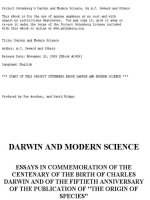Project Gutenberg''''s Researches on Cellulose, by C. F. Cross and E. J. Bevan pptx
Bạn đang xem bản rút gọn của tài liệu. Xem và tải ngay bản đầy đủ của tài liệu tại đây (1.33 MB, 580 trang )
Project Gutenberg's Researches on
Cellulose, by C. F. Cross and E. J. Bevan
This eBook is for the use of anyone
anywhere at no cost and with
almost no restrictions whatsoever. You may
copy it, give it away or
re-use it under the terms of the Project
Gutenberg License included
with this eBook or online at
www.gutenberg.org
Title: Researches on Cellulose
1895-1900
Author: C. F. Cross
E. J. Bevan
Release Date: September 16, 2007 [EBook
#22620]
Language: English
*** START OF THIS PROJECT GUTENBERG EBOOK
RESEARCHES ON CELLULOSE ***
Produced by Juliet Sutherland, Josephine
Paolucci and the
Online Distributed Proofreading Team at
.
(This file was produced from images
generously made
available by The Internet Archive/Million
Book Project).
RESEARCHES
ON CELLULOSE
1895-1900
BY
CROSS & BEVAN
(C. F. CROSS AND E. J. BEVAN)
SECOND EDITION
LONGMANS, GREEN, AND CO.
39 PATERNOSTER ROW, LONDON
NEW YORK, BOMBAY, AND
CALCUTTA
1907
All rights reserved
Transcriber's note: The
sections in the Table of
Contents are not used in the
actual text. They have been
added for clarity. Minor typos
have been corrected and
footnotes moved to the end of
the sections
PREFACE TO
SECOND EDITION
This edition is a reprint of the first in
response to a continuous demand for the
book. The matter, consisting as it does
largely of records, does not call for any
revision, and, as a contribution to the
development of theory, any particular
interest which it has is associated with the
date at which it was written.
The volume which has since appeared is
the sequel, and aims at an exposition of
the subject "to date".
This volume, which is intended as a
supplement to the work which we
published in 1895, gives a brief account
of researches which have been
subsequently published, as well as of
certain of our own investigations, the
results of which are now for the first time
recorded.
We have not attempted to give the subject-
matter the form of a connected record. The
contributions to the study of 'Cellulose'
which are noticed are spread over a large
area, are mostly 'sectional' in their aim,
and the only cohesion which we can give
them is that of classifying them according
to the plan of our original work. Their
subject-matter is reproduced in the form
of a précis, as much condensed as
possible; of the more important papers the
original title is given. In all cases we have
endeavoured to reproduce the Author's
main conclusions, and in most cases
without comment or criticism.
Specialists will note that the basis of
investigation is still in a great measure
empirical; and of this the most obvious
criterion is the confusion attaching to the
use of the very word 'Cellulose.' This is
due to various causes, one of which is the
curious specialisation of the term in
Germany as the equivalent of 'wood
cellulose.' The restriction of this general
or group term has had an influence even in
scientific circles. Another influence
preventing the recognition of the obvious
and, as we think, inevitable basis of
classification of the 'celluloses' is the
empiricism of the methods of agricultural
chemistry, which as regards cellulose are
so far chiefly concerned with its negative
characteristics and the analytical
determination of the indigestible residue
of fodder plants. Physiologists, again,
have their own views and methods in
dealing with cellulose, and have hitherto
had but little regard to the work of the
chemist in differentiating and classifying
the celluloses on a systematic basis. There
are many sides to the subject, and it is
only by a sustained effort towards
centralisation that the general recognition
of a systematic basis can be secured.
We may, we hope usefully, direct attention
to the conspicuous neglect of the subject in
this country. To the matter of the present
volume, excluding our own investigations,
there are but two contributions from
English laboratories. We invite the
younger generation of students of
chemistry to measure the probability of
finding a working career in connection
with the cellulose industries. They will
not find this invitation in the treatment
accorded to the subject in text-books and
lectures. It is probable, indeed, that the
impression produced by their studies is
that the industries in coal-tar products
largely exceed in importance those of
which the carbohydrates are the basis;
whereas the former are quite insignificant
by comparison. A little reflection will
prove that cellulose, starch, and sugar are
of vast industrial moment in the order in
which they are mentioned. If it is an open
question to what extent science follows
industry, or vice versa, it is not open to
doubt that scientific men, and especially
chemists, are called in these days to lead
and follow where industrial evolution is
most active. There is ample evidence of
activity and great expansion in the
cellulose industries, especially in those
which involve the chemistry of the raw
material; and the present volume should
serve to show that there is rapid advance
in the science of the subject. Hence our
appeal to the workers not to neglect those
opportunities which belong to the days of
small beginnings.
We have especially to acknowledge the
services of Mr. J. F. Briggs in
investigations which are recorded on pp.
34-40 and pp. 125-133 of the text.
CONTENTS
THE MATTER OF THIS
VOLUME MAY BE
DIVIDED INTO THE
FOLLOWING SECTIONS
INTRODUCTION—DEALING WITH
THE SUBJECT IN GENERAL OUTLINE
SECTION
I. GENERAL CHEMISTRY OF THE
TYPICAL COTTON CELLULOSE
II. SYNTHETICAL DERIVATIVES—
SULPHOCARBONATES AND ESTERS
III. DECOMPOSITIONS OF
CELLULOSE SUCH AS THROW LIGHT
ON THE PROBLEM OF ITS
CONSTITUTION
IV. CELLULOSE GROUP, INCLUDING
HEMICELLULOSES AND TISSUE
CONSTITUENTS OF FUNGI
V. FURFUROIDS, i.e. PENTOSANES
AND FURFURAL-YIELDING
CONSTITUENTS GENERALLY
VI. THE LIGNOCELLULOSES
VII. PECTIC GROUP
VIII. INDUSTRIAL AND TECHNICAL.
GENERAL REVIEW
INDEX OF AUTHORS
INDEX OF SUBJECTS
CELLULOSE
INTRODUCTION
In the period 1895-1900, which has
elapsed since the original publication of
our work on 'Cellulose,' there have
appeared a large number of publications
dealing with special points in the
chemistry of cellulose. So large has been
the contribution of matter that it has been
considered opportune to pass it under
review; and the present volume, taking the
form of a supplement to the original work,
is designed to incorporate this new matter
and bring the subject as a whole to the
level to which it is thereby to be raised.
Some of our critics in reviewing the
original work have pronounced it
'inchoate.' For this there are some
explanations inherent in the matter itself. It
must be remembered that every special
province of the science has its systematic
beginning, and in that stage of evolution
makes a temporary 'law unto itself.' In the
absence of a dominating theory or
generalisation which, when adopted, gives
it an organic connection with the general
advance of the science, there is no other
course than to classify the subject-matter.
Thus 'the carbohydrates' may be said to
have been in the inchoate condition,
qualified by a certain classification, prior
to the pioneering investigations of Fischer.
In attacking the already accumulated and
so far classified material from the point of
view of a dominating theory, he found not
only that the material fell into systematic
order and grew rapidly under the stimulus
of fruitful investigation, but in turn
contributed to the firmer establishment of
the theoretical views to which the subject
owed its systematic new birth. On the
other hand, every chemist knows that it is
only the simpler of the carbohydrates
which are so individualised as to be
connoted by a particular formula in the
stereoisomeric system. Leaving the
monoses, there is even a doubt as to the
constitution of cane sugar; and the
elements of uncertainty thicken as we
approach the question of the chemical
structure of starch. This unique product of
plant life has a literature of its own, and
how little of this is fully known to what
we may term the 'average chemist' is seen
by the methods he will employ for its
quantitative estimation. In one particular
review of our work where we are taken to
task for producing 'an aggravating book,
inchoate in the highest degree
disfigured by an obscurity of diction
which must materially diminish its
usefulness' ['Nature,' 1897, p. 241], the
author, who is a well-known and
competent critic, makes use of the short
expression in regard to the more complex
carbohydrates, 'Above cane sugar, higher
in the series, all is chaos,' and in reference
to starch, 'the subject is still enshrouded in
mystery.' This 'material' complexity is at
its maximum with the most complex
members of the series, which are the
celluloses, and we think accounts in part
for the impatience of our critic. 'Obscurity
of diction' is a personal quantity, and we
must leave that criticism to the fates. We
find also that many workers whose
publications we notice in this present
volume quite ignore the plan of the work,
though they make use of its matter. We
think it necessary to restate this plan,
which, we are satisfied, is systematic,
and, in fact, inevitable. Cellulose is in the
first instance a structure, and the
anatomical relationships supply a certain
basis of classification. Next, it is known
to us and is defined by the negative
characteristics of resistance to hydrolytic
actions and oxidations. These are dealt
with in the order of their intensity. Next
we have the more positive definition by
ultimate products of hydrolysis, so far as
they are known, which discloses more
particularly the presence of a greater or
less proportion of furfural-yielding
groups. Putting all these together as
criteria of function and composition we
find they supply common or general
dividing lines, within which groups of
these products are contained. The
classification is natural, and in that sense
inevitable; and it not only groups the
physiological and chemical facts, but the
industrial also. We do not propose to
argue the question whether the latter adds
any cogency to a scientific scheme. We
are satisfied that it does, and we do not
find any necessity to exclude a particular
set of phenomena from consideration,
because they involve 'commercial' factors.
We have dealt with this classification in
the original work (p. 78), and we discuss
its essential basis in the present volume
(p. 28) in connection with the definition of
a 'normal' cellulose. But the 'normal'
cellulose is not the only cellulose, any
more than a primary alcohol or an
aliphatic alcohol are the only alcohols.
This point is confused or ignored in
several of the recent contributions of
investigators. It will suffice to cite one of
these in illustration. On p. 16 we give an
account of an investigation of the several
methods of estimating cellulose, which is
full of valuable and interesting matter. The
purpose of the author's elaborate
comparative study is to decide which has
the strongest claims to be regarded as the
'standard' method. They appear to have a
preference for the method of Lange—viz.
that of heating at high temperatures (180°)
with alkaline hydrates, but the









